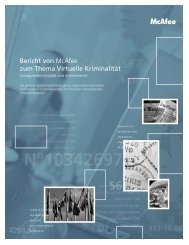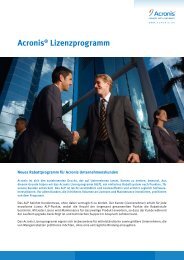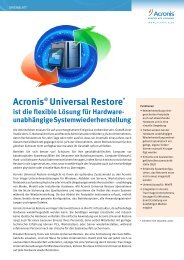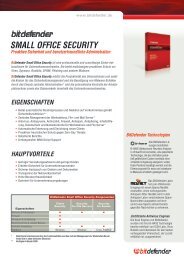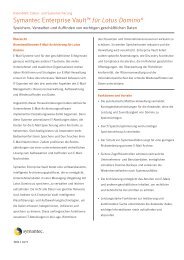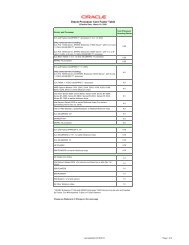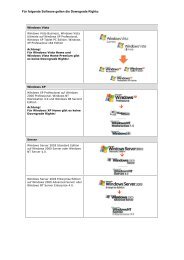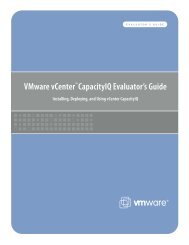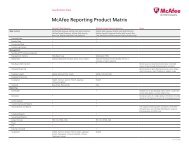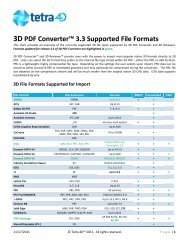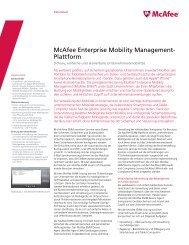A Closer Look at the RamSan-710
A Closer Look at the RamSan-710
A Closer Look at the RamSan-710
You also want an ePaper? Increase the reach of your titles
YUMPU automatically turns print PDFs into web optimized ePapers that Google loves.
Performance<br />
Performance is key to a quality SSD. The <strong>RamSan</strong>-<strong>710</strong> is <strong>the</strong> l<strong>at</strong>est SSD from TMS,<br />
maintaining <strong>the</strong> <strong>RamSan</strong> line’s position as <strong>the</strong> World’s Fastest Storage®. The<br />
<strong>RamSan</strong>-<strong>710</strong> boasts <strong>the</strong> following key performance metrics:<br />
35 microsecond access time (writes)<br />
175 microsecond access time (reads)<br />
400,000 sustained random IOPS (writes)<br />
400,000 sustained random IOPS (reads)<br />
5 GB/second peak bandwidth<br />
The key measure of <strong>the</strong> <strong>RamSan</strong>-<strong>710</strong>’s capabilities is its ability to sustain extreme<br />
inputs/outputs per second (IOPS) even with mixed read/write workloads. This is<br />
important because most applic<strong>at</strong>ions have a mixture of reads and writes with a<br />
gre<strong>at</strong> deal of random access. Most o<strong>the</strong>r Flash SSDs and hard disk drive (HDD)<br />
solutions suffer significant performance degrad<strong>at</strong>ion from ei<strong>the</strong>r random access<br />
p<strong>at</strong>terns or write accesses, if not both. For example, most Flash SSDs suffer<br />
disproportion<strong>at</strong>ely if <strong>the</strong>y experience even a small percentage of writes, to <strong>the</strong> point<br />
th<strong>at</strong> <strong>the</strong>ir mixed read/write performance may actually be dram<strong>at</strong>ically less than<br />
<strong>the</strong>ir peak write performance. In practice, this means th<strong>at</strong> a <strong>RamSan</strong>-<strong>710</strong> will deliver<br />
better sustained “real world” random read/write applic<strong>at</strong>ion performance than any<br />
o<strong>the</strong>r Flash SSD.<br />
And if o<strong>the</strong>r Flash SSDs have difficulty competing with <strong>the</strong> performance of <strong>the</strong><br />
<strong>RamSan</strong>-<strong>710</strong>, hard disk drives can’t even get in <strong>the</strong> ballpark. Consider this: high<br />
performance 15K RPM Fibre Channel (FC) HDDs can achieve <strong>at</strong> best 300 IOPS. At<br />
th<strong>at</strong> IOPS r<strong>at</strong>e, it would take well over 1,300 HDDs to equal <strong>the</strong> performance of one<br />
<strong>RamSan</strong>-<strong>710</strong>. This means almost 100 disk enclosures in seven racks, all of which<br />
would draw over 16,000 w<strong>at</strong>ts, while one <strong>RamSan</strong>-<strong>710</strong> uses 280!<br />
You can also compare HDD to <strong>the</strong> <strong>RamSan</strong>-<strong>710</strong> on <strong>the</strong> basis of capacity and<br />
performance. The highest-performing 15K RPM FC HDDs usually provide 146 GB of<br />
capacity. One disk enclosure would offer 2 TB of “raw” storage, but deploying <strong>the</strong>se<br />
drives in RAID 10 sets for performance and reliability would actually offer only 1 TB<br />
of usable capacity for each 3U 14 drive disk enclosure. To equal <strong>the</strong> <strong>RamSan</strong>-<strong>710</strong>’s<br />
5 TB capacity you would need five of <strong>the</strong>se enclosures and 70 disks. Combined with<br />
<strong>the</strong> controller (ano<strong>the</strong>r 3U), <strong>the</strong> full disk solution would require 18U (half a rack),<br />
draw around 2,000 w<strong>at</strong>ts, and provide only a few percent of <strong>the</strong> performance of <strong>the</strong><br />
<strong>RamSan</strong>-<strong>710</strong>. Perhaps most surprisingly, if you include <strong>the</strong> power, space, and cooling<br />
costs with <strong>the</strong> upfront acquisition costs of a disk controller with 70 disks, <strong>the</strong><br />
<strong>RamSan</strong>-<strong>710</strong> may be <strong>the</strong> LESS expensive solution.<br />
July 2011 8 Texas Memory Systems



